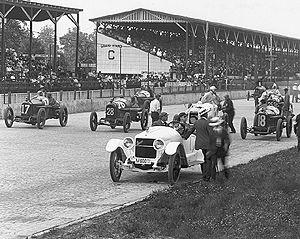1916 Indianapolis 500
 |
|||||
| Indianapolis Motor Speedway | |||||
|---|---|---|---|---|---|
| Indianapolis 500 | |||||
| Sanctioning body | AAA | ||||
| Date | May 30, 1916 | ||||
| Winner | Dario Resta | ||||
| Winning Entrant | Peugeot | ||||
| Average speed | 84.001 mph (135.187 km/h) | ||||
| Pole position | Johnny Aitken | ||||
| Pole speed | 96.69 mph (155.61 km/h) | ||||
| Most laps led | Resta (103) | ||||
| Pre-race | |||||
| Pace car | Premier 6 (Model 6-56) | ||||
| Pace car driver | Frank E. Smith | ||||
| Chronology | |||||
|
|||||
The 6th International 300-Mile Sweepstakes Race was the sixth running of the Indianapolis 500. It was held at the Indianapolis Motor Speedway on Tuesday, May 30, 1916. The management scheduled the race for 120 laps, 300 miles (480 km), the only Indianapolis 500 scheduled for less than 500 miles (800 km).
Although the common belief is that the race distance was changed due to the onset of World War I, it was in fact Speedway management that changed the distance in order to make the race shorter and more appealing to fans. Despite the one-time altered distance, the race is still considered part of the continuous lineage of the Memorial Day classic, known as the Indianapolis 500. In addition to the altered distance, the start time was moved from 10:00 a.m. to the early afternoon (1:30 p.m.)
Eddie Rickenbacker took the lead at the start, and led the first nine laps until dropping out with steering problems. Dario Resta led 103 of the 120 laps, and claimed the victory. Resta was accompanied by riding mechanic Bob Dahnke.
Seven of the cars were entered by the Speedway or its owners, in order to ensure a strong field during the war. None of them finished in the top five. Despite the promoter's entries, the field consisted of only 21 cars, the smallest in Indy history.
Three months after the 1916 race, on Labor Day weekend of 1916, the Speedway held a second event, the Harvest Auto Racing Classic. The 1917 race was scheduled to return to 500 miles, but a dispute with the local hoteliers and the escalation of World War I intervened. On March 23, 1917, Speedway management cancelled the 1917 Indianapolis 500, and halted racing at the facility for both 1917 and 1918.
The track was offered as a landing strip and maintenance/refueling station for military aircraft traveling between Wilbur Wright Field and Chanute Air Force Base. It was referred to as the Speedway Aviation Repair Depot, and the 821st Aero Repair Squadron was stationed there. In addition, several experimental aircraft were tested at the grounds. At least one test pilot was fatally injured in a plane crash at the track.
...
Wikipedia
